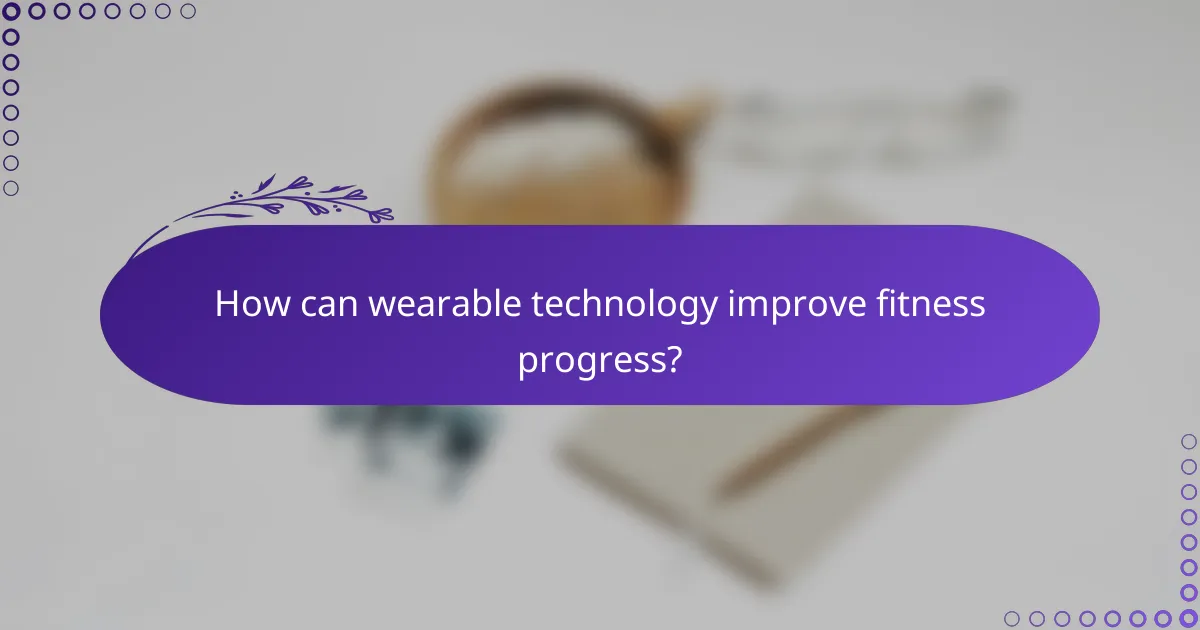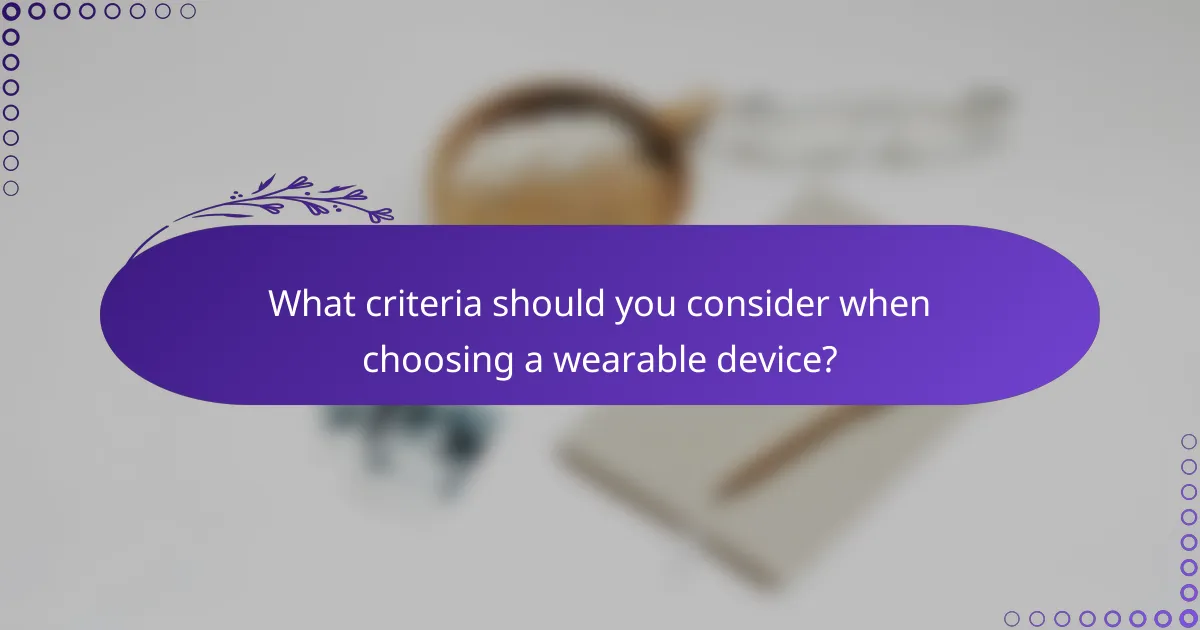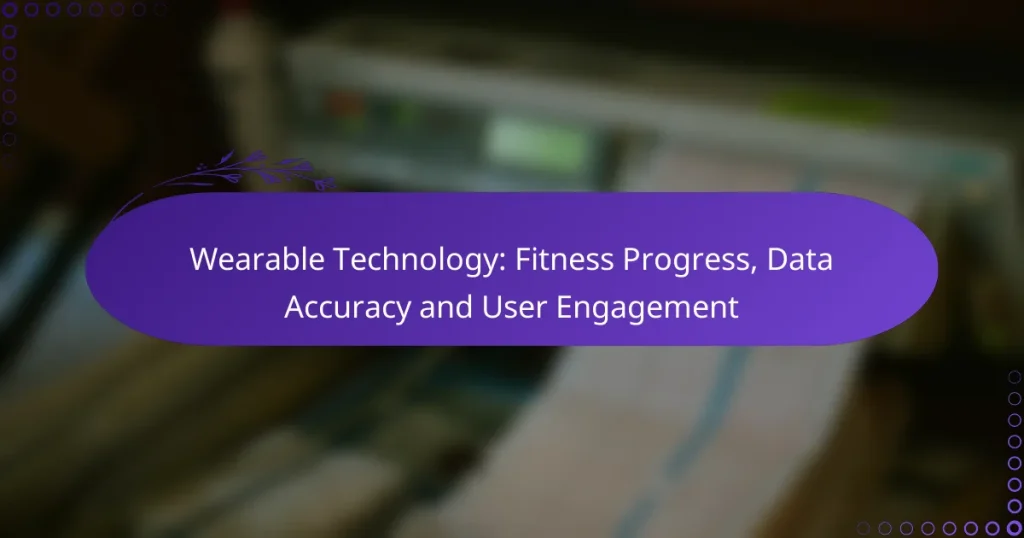Wearable technology plays a crucial role in enhancing fitness progress by delivering real-time data and personalized insights that empower users to optimize their workouts. While the accuracy of data can vary based on device quality and user habits, these devices foster greater user engagement, which is essential for maintaining motivation and achieving fitness goals. By leveraging these tools, individuals can make informed decisions that lead to improved health and well-being.

How can wearable technology improve fitness progress?
Wearable technology enhances fitness progress by providing users with real-time data on their physical activities, personalized workout plans, and seamless integration with fitness applications. These features help individuals monitor their performance, stay motivated, and make informed decisions about their fitness journeys.
Real-time tracking of physical activity
Real-time tracking allows users to monitor their physical activities as they happen, providing immediate feedback on metrics such as steps taken, heart rate, and calories burned. This instant data can motivate users to push harder during workouts or adjust their routines based on performance.
Many wearables offer features like GPS tracking for outdoor activities, which can help users analyze their routes and improve their endurance over time. Users should look for devices that offer accurate tracking and easy-to-read displays for the best experience.
Personalized workout recommendations
Wearable devices often use collected data to generate personalized workout recommendations tailored to individual fitness levels and goals. These suggestions can help users focus on specific areas, such as strength training or cardiovascular fitness, enhancing overall effectiveness.
For optimal results, users should regularly update their fitness goals within the wearable app, allowing the device to adjust recommendations based on progress. This adaptability can prevent plateaus and keep users engaged in their fitness journey.
Integration with fitness apps like MyFitnessPal
Integration with popular fitness apps, such as MyFitnessPal, allows users to sync their activity data with nutrition tracking, creating a comprehensive view of their health. This connection helps users understand the relationship between their diet and exercise, leading to more informed choices.
To maximize benefits, users should ensure their wearable device is compatible with their preferred fitness apps and regularly log their food intake. This practice can enhance accountability and support better fitness outcomes.

What is the accuracy of data from wearable devices?
The accuracy of data from wearable devices varies by type and brand, influencing their reliability for fitness tracking. Factors such as sensor quality, user behavior, and environmental conditions can all affect the precision of the data collected.
Heart rate monitoring accuracy of Fitbit Charge 5
The Fitbit Charge 5 utilizes photoplethysmography to measure heart rate, which generally provides reliable readings during steady-state activities. However, accuracy can decrease during high-intensity workouts or irregular movements, with potential discrepancies of up to 10 beats per minute compared to clinical devices.
To ensure better heart rate accuracy, wear the device snugly on your wrist and keep it clean. Regularly updating the device’s firmware can also enhance performance and data reliability.
GPS tracking precision in Garmin Forerunner 245
The Garmin Forerunner 245 is equipped with GPS technology that typically offers high accuracy in tracking distance and pace during outdoor activities. However, urban environments with tall buildings or dense tree cover may lead to signal interference, resulting in errors of several meters.
For optimal GPS performance, start your run in an open area to allow the device to establish a strong satellite connection. Consider using the device’s built-in features to calibrate the GPS for improved accuracy over time.
Calorie estimation reliability in Apple Watch Series 7
The Apple Watch Series 7 estimates calories burned using a combination of heart rate data, activity type, and user-provided metrics like age and weight. While generally effective, calorie estimates can vary significantly, sometimes by 20-30%, depending on the intensity of the exercise and individual metabolic differences.
To enhance calorie tracking accuracy, ensure your personal information is correctly entered in the Health app and regularly update your activity levels. Engaging in consistent workouts can help the device refine its estimations over time.

How does user engagement affect fitness outcomes?
User engagement significantly influences fitness outcomes by motivating individuals to maintain consistent exercise routines and track their progress. Higher engagement levels often lead to better adherence to fitness goals, resulting in improved health metrics and overall well-being.
Gamification features in Strava
Strava incorporates gamification elements like challenges, leaderboards, and achievements to enhance user engagement. These features encourage users to compete against themselves and others, fostering a sense of community and motivation.
For example, users can participate in monthly challenges that reward them for completing specific distances or activities. This not only makes workouts more enjoyable but also drives users to push their limits, ultimately improving their fitness outcomes.
Social sharing capabilities of Samsung Galaxy Watch
The Samsung Galaxy Watch allows users to share their fitness achievements on social media platforms, enhancing engagement through social interaction. This capability encourages users to celebrate milestones with friends and family, creating a supportive environment.
Sharing workouts can lead to increased accountability, as users may feel more motivated to stay active when their progress is visible to others. Additionally, the ability to join group challenges through social media can further boost participation and commitment to fitness goals.
Challenges and rewards in Fitbit app
The Fitbit app features a variety of challenges and rewards that keep users engaged and motivated. Users can join challenges with friends or family, competing to reach specific activity goals or step counts.
Rewards such as badges and recognition for achieving milestones provide positive reinforcement, encouraging users to stay committed to their fitness journeys. This system not only enhances motivation but also fosters a sense of community among users, which can lead to better fitness outcomes over time.

What criteria should you consider when choosing a wearable device?
When selecting a wearable device, consider factors such as data accuracy, battery life, compatibility with other devices, and user engagement features. These criteria will help you find a device that meets your fitness goals and integrates seamlessly into your lifestyle.
Battery life comparison among major brands
Battery life is a crucial factor when choosing a wearable device, as it affects how often you need to recharge. Most fitness trackers offer battery life ranging from a few days to several weeks, depending on usage and features. For example, brands like Fitbit typically provide 5 to 10 days, while Garmin devices can last up to two weeks or more.
Consider your activity level and how often you plan to use features like GPS or heart rate monitoring, which can drain the battery faster. If you prefer a device that requires minimal charging, look for models known for their longevity.
Compatibility with smartphones and fitness platforms
Compatibility with smartphones and fitness platforms is essential for maximizing the functionality of your wearable device. Ensure that the device you choose works with your smartphone’s operating system, whether it’s iOS or Android. Most major brands like Apple, Samsung, and Fitbit have apps that sync data seamlessly with their devices.
Additionally, check if the wearable integrates with popular fitness platforms such as Strava or MyFitnessPal. This compatibility allows you to track your progress across multiple apps and share data with friends, enhancing user engagement and motivation.

What are the emerging trends in wearable technology?
Emerging trends in wearable technology focus on enhanced user engagement, improved data accuracy, and personalized fitness progress tracking. These advancements are reshaping how individuals monitor their health and fitness, making wearables more integral to daily life.
Integration of AI for personalized insights
The integration of artificial intelligence (AI) in wearable technology allows for more tailored health and fitness insights. AI algorithms analyze user data to provide personalized recommendations, such as optimal workout routines or dietary suggestions based on individual goals and performance metrics.
For example, smart fitness trackers can adapt their feedback based on user activity levels, sleep patterns, and even stress indicators. This level of customization enhances user motivation and engagement, as individuals receive actionable insights that resonate with their personal health journeys.
Advancements in health monitoring capabilities
Recent advancements in health monitoring have expanded the capabilities of wearables beyond basic fitness tracking. Devices now commonly feature sensors that can monitor heart rate variability, blood oxygen levels, and even electrocardiograms (ECGs), providing users with a comprehensive view of their health status.
These enhanced monitoring features are particularly valuable for individuals managing chronic conditions or those looking to optimize their fitness regimens. Users should consider wearables that comply with health regulations, such as FDA approval in the U.S., to ensure data accuracy and reliability.
Future of smart clothing and textiles
The future of smart clothing and textiles is poised to revolutionize the wearable technology landscape. Innovations in fabric technology allow for the integration of sensors directly into clothing, enabling continuous health monitoring without the need for traditional devices.
For instance, smart shirts can track heart rate and respiration, while smart socks can monitor foot pressure and temperature. As these technologies evolve, consumers can expect more seamless and comfortable options that blend functionality with everyday wear, enhancing both fitness tracking and overall user experience.


